
Am Fam Physician. 2017;95(5):314-321
Related editorial: Addressing the Needs of LGBT Patients.
Related letter: Contraception Should Be Addressed with Women Who Have Sex with Women
Patient information: See related handout on health care for women who have sex with women, written by the authors of this article.
Author disclosure: No relevant financial affiliations.
Despite recent shifts in societal attitudes toward same-sex relationships, women who have sex with women face a variety of barriers to optimal health, including a history of negatively perceived interactions in clinical settings that lead them to delay or avoid health care. Women who have sex with women may be at disproportionate risk of obesity, tobacco use, substance use, mental health issues, intimate partner violence, sexually transmitted infections, and some cancers. Disparities can exist throughout the lifetime. Lesbian and bisexual adolescents are vulnerable to bullying, family rejection, and risky sexual behavior that may lead to sexually transmitted infections or unintended pregnancy. Sexual minority stress, which is a response to stigmatization, prejudice, and internalized homophobia, contributes to many of these conditions. Family physicians should foster trust and communication to provide a nonjudgmental, welcoming environment supportive of culturally competent health care and optimal outcomes. When indicated, clinicians should refer women who have sex with women to culturally sensitive community resources and legal advisors for assistance with medical decision making, hospital visitation, conception, and legal recognition of nonbiologic parents.
Quantifying the number of lesbians and bisexual women in the United States is challenging, in part because self-reported sexual identity does not always correlate with sexual behavior.1 While the prevalence of lifetime same-sex behavior by women is estimated at 7.1% to 11.2%, the number of women self-identifying as a sexual minority (Table 12–6 ) tends to be lower. One study found that 1.3% to 1.9% of U.S. women identified as lesbians and 3.1% to 4.8% identified as bisexual.7
| Clinical recommendation | Evidence rating | References |
|---|---|---|
| WSW should be screened for obesity, type 2 diabetes mellitus, cancer, and cardiovascular disease. | C | 2, 8, 17, 27, 36 |
| Regular Papanicolaou testing should be performed in WSW, and these patients should be referred for mammography according to guidelines for all women. | C | 10, 11, 36 |
| WSW should be screened for depression, anxiety, and suicide risk. | B (depression) | 2, 8, 9, 22, 23, 25, 26, 36, 37 |
| C (anxiety, suicide) | ||
| WSW should be screened for substance use, including tobacco, alcohol, and illicit drugs. | A (tobacco) | 2, 8, 16, 23, 32, 33, 36, 39 |
| B (alcohol) | ||
| C (illicit drugs) | ||
| WSW should be screened for sexually transmitted infections following standard guidelines for all females, according to behaviors and risks. | C | 1, 7, 8, 15, 21, 30 |
| WSW should be screened for intimate partner violence. | B | 12, 42 |
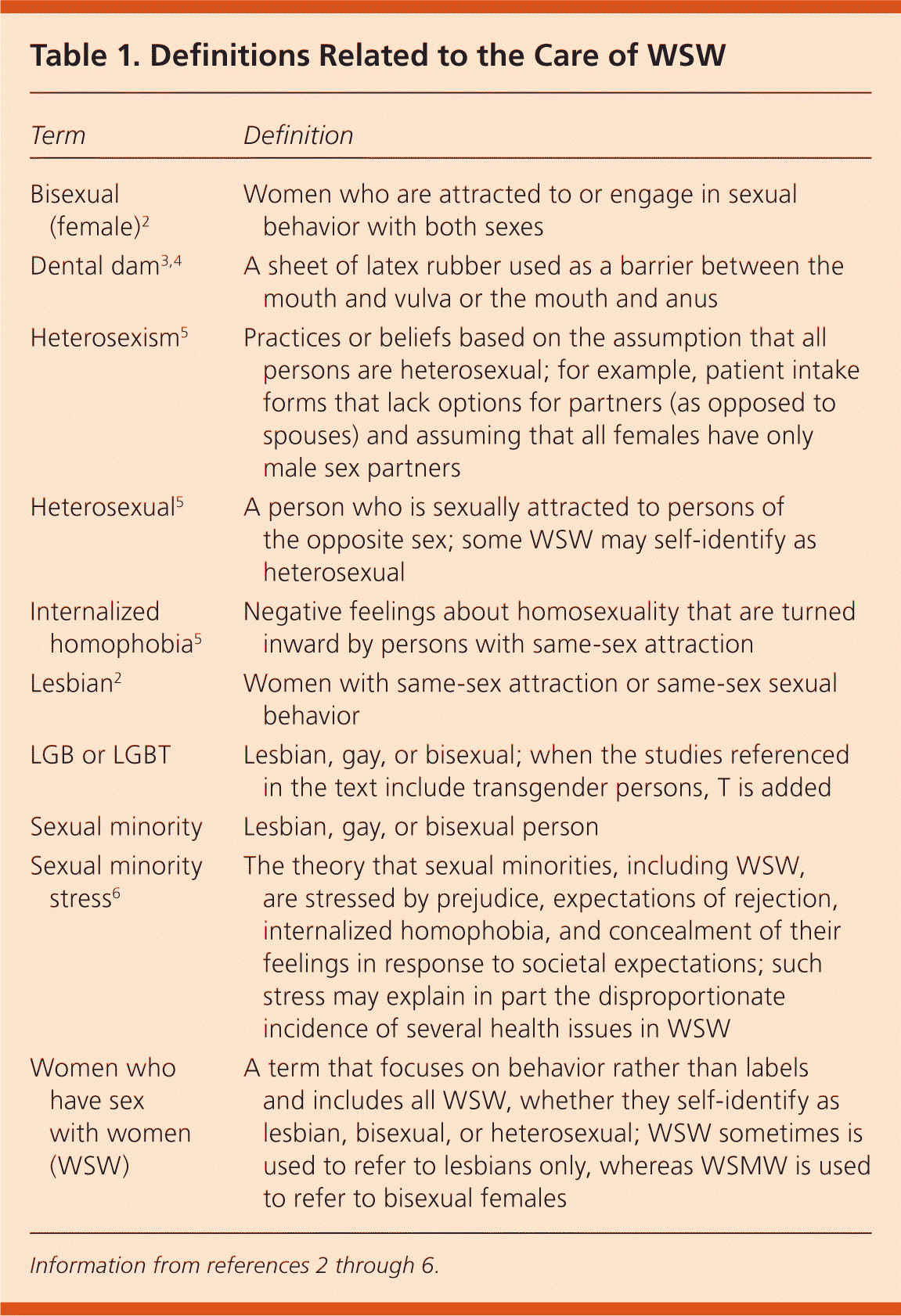
| Term | Definition |
|---|---|
| Bisexual (female)2 | Women who are attracted to or engage in sexual behavior with both sexes |
| Dental dam3,4 | A sheet of latex rubber used as a barrier between the mouth and vulva or the mouth and anus |
| Heterosexism5 | Practices or beliefs based on the assumption that all persons are heterosexual; for example, patient intake forms that lack options for partners (as opposed to spouses) and assuming that all females have only male sex partners |
| Heterosexual5 | A person who is sexually attracted to persons of the opposite sex; some WSW may self-identify as heterosexual |
| Internalized homophobia5 | Negative feelings about homosexuality that are turned inward by persons with same-sex attraction |
| Lesbian2 | Women with same-sex attraction or same-sex sexual behavior |
| LGB or LGBT | Lesbian, gay, or bisexual; when the studies referenced in the text include transgender persons, T is added |
| Sexual minority | Lesbian, gay, or bisexual person |
| Sexual minority stress6 | The theory that sexual minorities, including WSW, are stressed by prejudice, expectations of rejection, internalized homophobia, and concealment of their feelings in response to societal expectations; such stress may explain in part the disproportionate incidence of several health issues in WSW |
| Women who have sex with women (WSW) | A term that focuses on behavior rather than labels and includes all WSW, whether they self-identify as lesbian, bisexual, or heterosexual; WSW sometimes is used to refer to lesbians only, whereas WSMW is used to refer to bisexual females |
Although cultural attitudes are evolving, women who have sex with women (WSW) are still less likely to have access to health care with culturally competent physicians. They also are at higher risk of multiple health conditions. Family physicians are well situated to address these disparities, but often they lack awareness because of limited training. They may unwittingly contribute to barriers by believing that a patient's sexual self-identity and behavior are not pertinent to competent patient care.
Barriers to Optimal Care
LACK OF A WELCOMING ENVIRONMENT
WSW may be alienated by practice websites and brochures that feature only heterosexual couples (Table 2).2,5,8–12 Intake forms that lack “partnered” options (as opposed to married or single) and staff members who assume that all patients are heterosexual are additional examples of an unwelcoming environment that has contributed to significant health barriers for sexual minorities.5,8,13
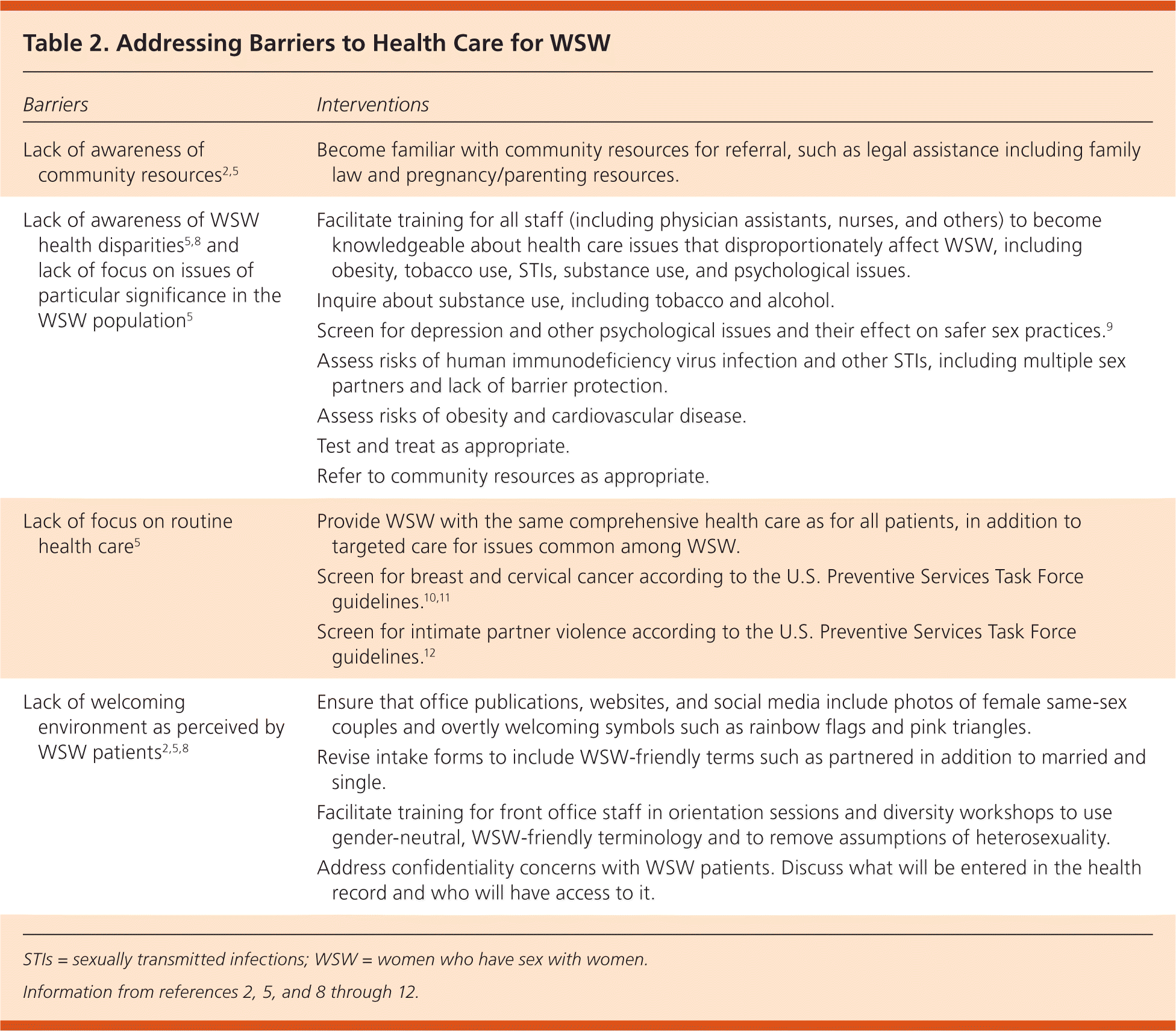
| Barriers | Interventions |
|---|---|
| Lack of awareness of community resources2,5 | Become familiar with community resources for referral, such as legal assistance including family law and pregnancy/parenting resources. |
| Lack of awareness of WSW health disparities5,8 and lack of focus on issues of particular significance in the WSW population5 | Facilitate training for all staff (including physician assistants, nurses, and others) to become knowledgeable about health care issues that disproportionately affect WSW, including obesity, tobacco use, STIs, substance use, and psychological issues. |
| Inquire about substance use, including tobacco and alcohol. | |
| Screen for depression and other psychological issues and their effect on safer sex practices.9 | |
| Assess risks of human immunodeficiency virus infection and other STIs, including multiple sex partners and lack of barrier protection. | |
| Assess risks of obesity and cardiovascular disease. | |
| Test and treat as appropriate. | |
| Refer to community resources as appropriate. | |
| Lack of focus on routine health care5 | Provide WSW with the same comprehensive health care as for all patients, in addition to targeted care for issues common among WSW. |
| Screen for breast and cervical cancer according to the U.S. Preventive Services Task Force guidelines.10,11 | |
| Screen for intimate partner violence according to the U.S. Preventive Services Task Force guidelines.12 | |
| Lack of welcoming environment as perceived by WSW patients2,5,8 | Ensure that office publications, websites, and social media include photos of female same-sex couples and overtly welcoming symbols such as rainbow flags and pink triangles. |
| Revise intake forms to include WSW-friendly terms such as partnered in addition to married and single. | |
| Facilitate training for front office staff in orientation sessions and diversity workshops to use gender-neutral, WSW-friendly terminology and to remove assumptions of heterosexuality. | |
| Address confidentiality concerns with WSW patients. Discuss what will be entered in the health record and who will have access to it. |
Physicians may inadvertently contribute to the unwelcoming environment because of a lack of knowledge about health issues that affect WSW and hesitancy to broach topics of a sexual nature. Because WSW may also hesitate to initiate frank discussion about sex, the possibility for poor communication and poor health outcomes is compounded.14
LACK OF HEALTH INSURANCE COVERAGE
Although same-sex marriage is now legal in the United States, WSW are still more likely to experience discrimination that affects employment, access to health insurance, and social programs that are appropriate for lesbian, gay, bisexual, or transgender (LGBT) persons.15
LACK OF COMMUNICATION
Lack of communication between patient and physician increases the risk of poor health outcomes, especially for WSW who hesitate to self-disclose to their family physicians. Sexual minority stress, a concept involving pressures such as expectations of rejection, internalized homophobia, and concealment of sexual minority status, can negatively impact the physician-patient relationship.6 Such stress may be particularly acute for sexual minority youth who fear that “coming out” will lead to prejudice or victimization, especially in school, and disapproval by family, friends, and physicians.16
LACK OF HIGH-QUALITY RESEARCH AND EVIDENCE-BASED GUIDELINES
Few population-based studies address the diversity within the LGBT population, including racial and ethnic identity, socioeconomic status, and geographic location.13 Much more robust research is needed to craft strong, evidence-based guidelines for health care in these populations.
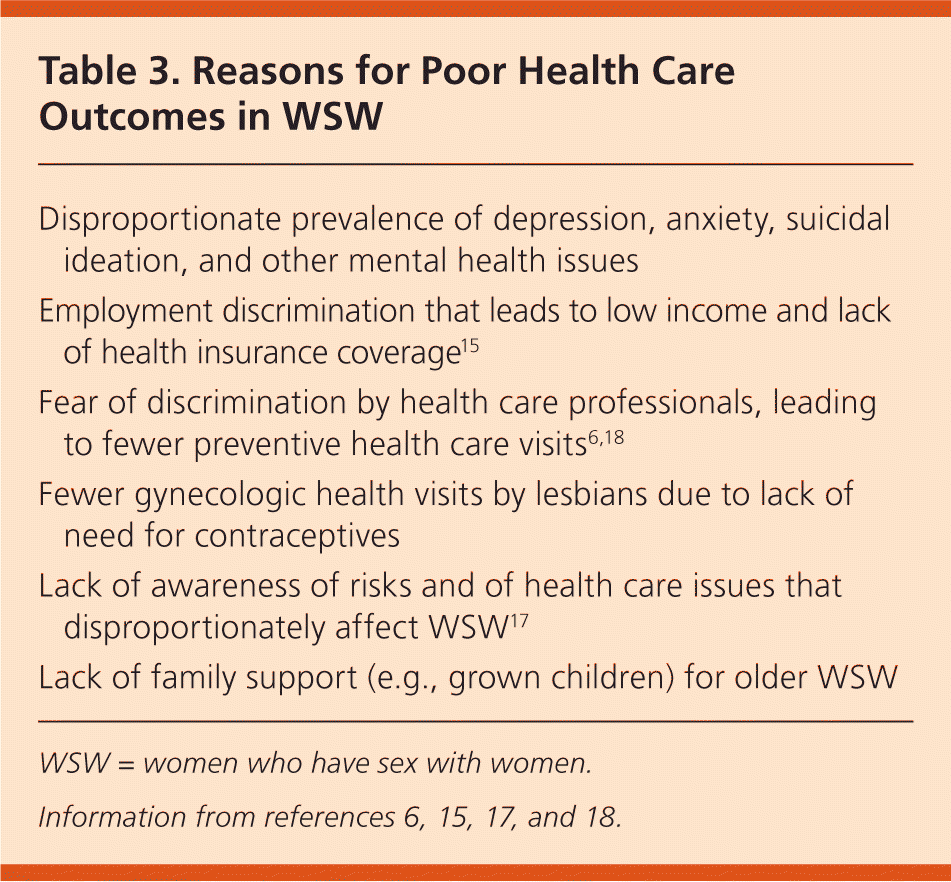
| Disproportionate prevalence of depression, anxiety, suicidal ideation, and other mental health issues |
| Employment discrimination that leads to low income and lack of health insurance coverage15 |
| Fear of discrimination by health care professionals, leading to fewer preventive health care visits6,18 |
| Fewer gynecologic health visits by lesbians due to lack of need for contraceptives |
| Lack of awareness of risks and of health care issues that disproportionately affect WSW17 |
| Lack of family support (e.g., grown children) for older WSW |
Management of Health Care for WSW
CREATING A THERAPEUTIC RELATIONSHIP
LGB persons, including WSW, are more likely to delay or avoid necessary medical care because of negative past experiences and fear of discrimination.19 Lesbians may avoid gynecologic health care because they may believe they do not need contraceptives and are at low risk of sexually transmitted infections (STIs).17 To counteract this issue, the family physician must make efforts to establish trust in a nonjudgmental, open environment.8 In the clinical setting, these efforts begin with an explanation that frank questions about sexual activities, behavioral health, and substance use are routine, and that the answers are confidential.
CONDUCTING A CULTURALLY COMPETENT HISTORY
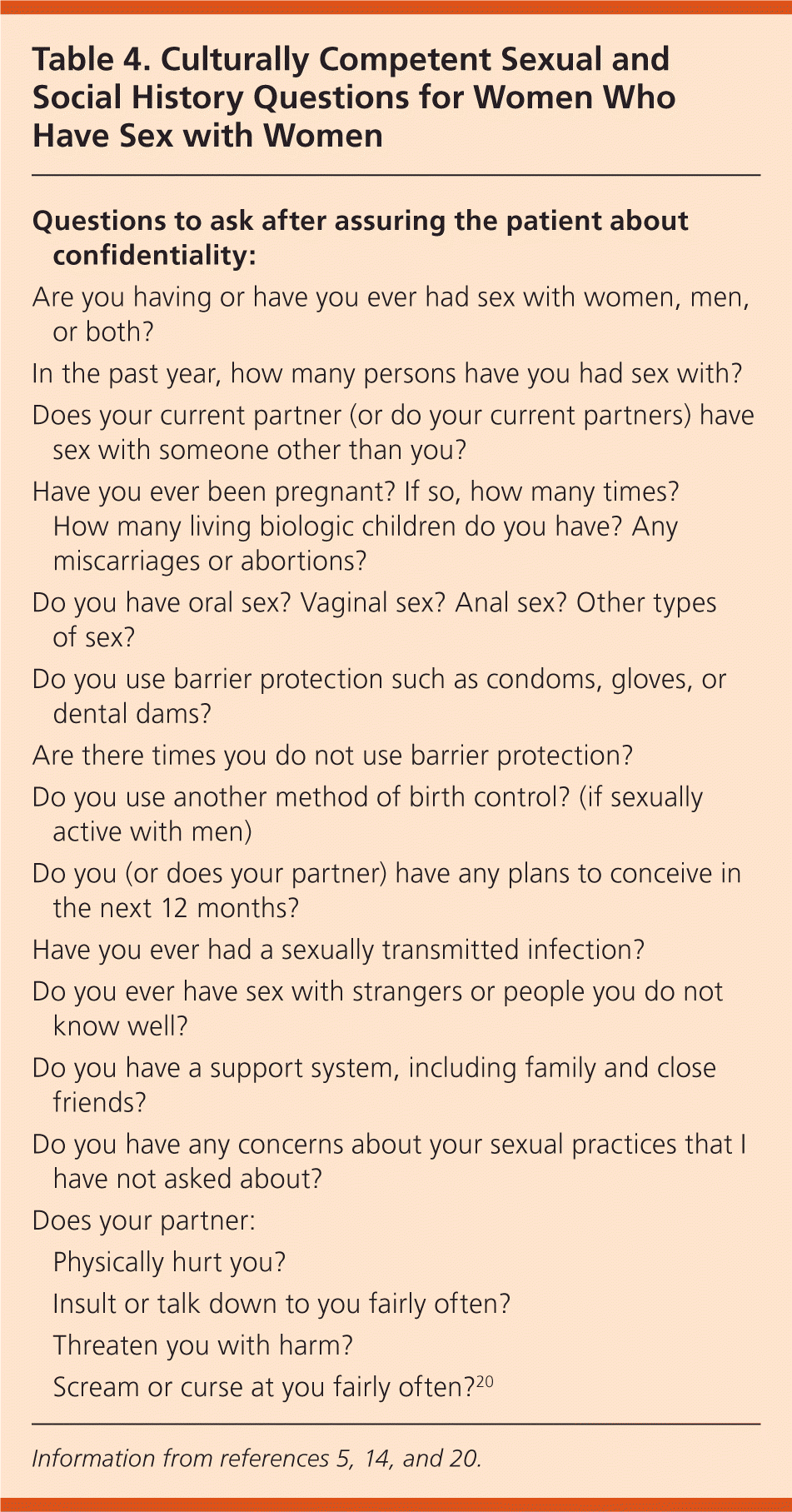
| Questions to ask after assuring the patient about confidentiality: | |
| Are you having or have you ever had sex with women, men, or both? | |
| In the past year, how many persons have you had sex with? | |
| Does your current partner (or do your current partners) have sex with someone other than you? | |
| Have you ever been pregnant? If so, how many times? | |
| How many living biologic children do you have? Any miscarriages or abortions? | |
| Do you have oral sex? Vaginal sex? Anal sex? Other types of sex? | |
| Do you use barrier protection such as condoms, gloves, or dental dams? | |
| Are there times you do not use barrier protection? | |
| Do you use another method of birth control? (if sexually active with men) | |
| Do you (or does your partner) have any plans to conceive in the next 12 months? | |
| Have you ever had a sexually transmitted infection? | |
| Do you ever have sex with strangers or people you do not know well? | |
| Do you have a support system, including family and close friends? | |
| Do you have any concerns about your sexual practices that I have not asked about? | |
| Does your partner: | |
| Physically hurt you? | |
| Insult or talk down to you fairly often? | |
| Threaten you with harm? | |
| Scream or curse at you fairly often?20 | |
Clear communication is supported through questions that focus on behavior (“Do you have sex with women, men, or both?”) rather than labels such as lesbian or bisexual because self-identity and sexual behaviors are not always strongly correlated.7 Generally speaking, a self-identity of being lesbian does not automatically exclude male sex partners, and having female sex partners does not necessarily lead to self-identification as lesbian or bisexual. Various studies have found that 53% to 97% of women who report same-sex sexual behavior have had or still have male sex partners.21 Another study found that among the 7% of women who reported a same-sex sexual relationship, 50% self-identified as heterosexual.1
Sexual minority adolescents face unique developmental challenges. To address their needs, the American Academy of Child and Adolescent Psychiatry recommends an age-appropriate assessment of psychosexual development for all youths, including inquiries about bullying, thoughts of suicide, high-risk behaviors, substance abuse, and STIs.22 The American Academy of Pediatrics states that physicians should not inform adolescents' parents or guardians about their sexual identity or behavior because doing so could lead to harm. If the parents or guardians are already aware of the adolescent's sexual identity or behavior, the physician should offer support with any adjustment issues.23
Health Issues That Disproportionately Affect WSW
Most health care concerns for WSW are the same as for any woman, though some risks are overrepresented in the WSW population (Table 5).2,7,14,16,17,21,23–33 The American Academy of Family Physicians (AAFP) recommends that family physicians be aware of the particular needs of adolescents, who may be struggling with issues of sexual identity or orientation that affect their psychosocial and physical health.34
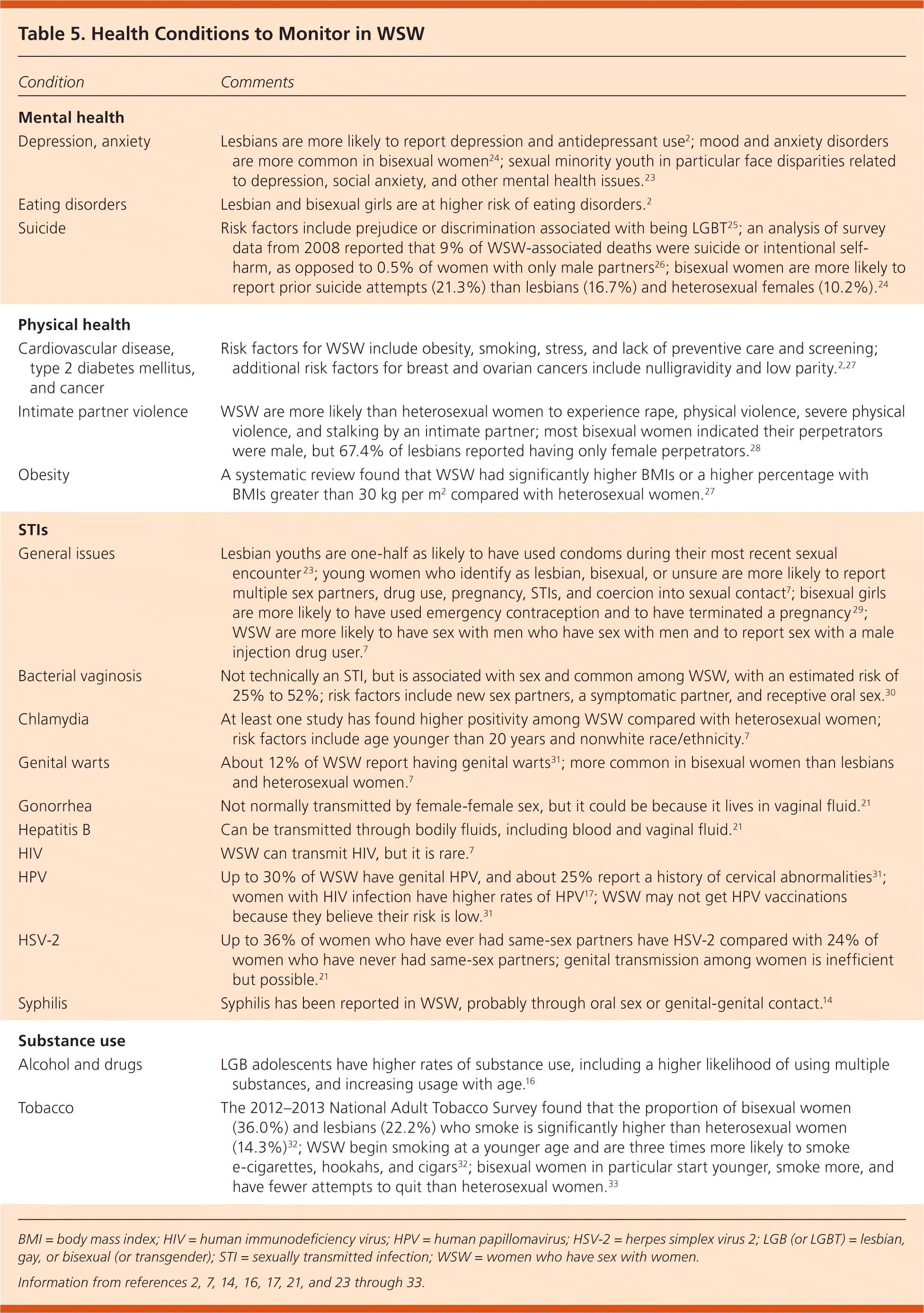
| Condition | Comments |
|---|---|
| Mental health | |
| Depression, anxiety | Lesbians are more likely to report depression and antidepressant use2; mood and anxiety disorders are more common in bisexual women24; sexual minority youth in particular face disparities related to depression, social anxiety, and other mental health issues.23 |
| Eating disorders | Lesbian and bisexual girls are at higher risk of eating disorders.2 |
| Suicide | Risk factors include prejudice or discrimination associated with being LGBT25; an analysis of survey data from 2008 reported that 9% of WSW-associated deaths were suicide or intentional self-harm, as opposed to 0.5% of women with only male partners26; bisexual women are more likely to report prior suicide attempts (21.3%) than lesbians (16.7%) and heterosexual females (10.2%).24 |
| Physical health | |
| Cardiovascular disease, type 2 diabetes mellitus, and cancer | Risk factors for WSW include obesity, smoking, stress, and lack of preventive care and screening; additional risk factors for breast and ovarian cancers include nulligravidity and low parity.2,27 |
| Intimate partner violence | WSW are more likely than heterosexual women to experience rape, physical violence, severe physical violence, and stalking by an intimate partner; most bisexual women indicated their perpetrators were male, but 67.4% of lesbians reported having only female perpetrators.28 |
| Obesity | A systematic review found that WSW had significantly higher BMIs or a higher percentage with BMIs greater than 30 kg per m2 compared with heterosexual women.27 |
| STIs | |
| General issues | Lesbian youths are one-half as likely to have used condoms during their most recent sexual encounter 23; young women who identify as lesbian, bisexual, or unsure are more likely to report multiple sex partners, drug use, pregnancy, STIs, and coercion into sexual contact7; bisexual girls are more likely to have used emergency contraception and to have terminated a pregnancy 29; WSW are more likely to have sex with men who have sex with men and to report sex with a male injection drug user.7 |
| Bacterial vaginosis | Not technically an STI, but is associated with sex and common among WSW, with an estimated risk of 25% to 52%; risk factors include new sex partners, a symptomatic partner, and receptive oral sex.30 |
| Chlamydia | At least one study has found higher positivity among WSW compared with heterosexual women; risk factors include age younger than 20 years and nonwhite race/ethnicity.7 |
| Genital warts | About 12% of WSW report having genital warts31; more common in bisexual women than lesbians and heterosexual women.7 |
| Gonorrhea | Not normally transmitted by female-female sex, but it could be because it lives in vaginal fluid.21 |
| Hepatitis B | Can be transmitted through bodily fluids, including blood and vaginal fluid.21 |
| HIV | WSW can transmit HIV, but it is rare.7 |
| HPV | Up to 30% of WSW have genital HPV, and about 25% report a history of cervical abnormalities31; women with HIV infection have higher rates of HPV17; WSW may not get HPV vaccinations because they believe their risk is low.31 |
| HSV-2 | Up to 36% of women who have ever had same-sex partners have HSV-2 compared with 24% of women who have never had same-sex partners; genital transmission among women is inefficient but possible.21 |
| Syphilis | Syphilis has been reported in WSW, probably through oral sex or genital-genital contact.14 |
| Substance use | |
| Alcohol and drugs | LGB adolescents have higher rates of substance use, including a higher likelihood of using multiple substances, and increasing usage with age.16 |
| Tobacco | The 2012–2013 National Adult Tobacco Survey found that the proportion of bisexual women (36.0%) and lesbians (22.2%) who smoke is significantly higher than heterosexual women (14.3%)32; WSW begin smoking at a younger age and are three times more likely to smoke e-cigarettes, hookahs, and cigars32; bisexual women in particular start younger, smoke more, and have fewer attempts to quit than heterosexual women.33 |
OBESITY
Although not all studies agree, there is research indicating that overall, lesbians and bisexual women have significantly greater body mass indexes compared with heterosexual women from adolescence forward.27 Some research suggests that lesbians are less concerned about weight issues27 and more likely to have poor nutrition habits.13
CARDIOVASCULAR DISEASE, TYPE 2 DIABETES MELLITUS, AND CANCER
The combination of higher rates of obesity, smoking, and stress puts WSW at higher risk of cardiovascular disease, type 2 diabetes mellitus, and some cancers (cervical, breast, ovarian, and lung).2 WSW have lower rates of Papanicolaou testing and tend to initiate screening later than heterosexual women. One study found that 25% of lesbians reported delaying Papanicolaou testing because of fear of discrimination.18 Lesbians may have increased risk of cervical cancer because of less screening and more behavioral risks, such as smoking and obesity.35
MENTAL HEALTH ISSUES
Compared with heterosexual women, the LGBT population has higher rates of mood and anxiety disorders, and suicidal ideation and behavior.37 Lesbian and bisexual adolescents are at higher risk of eating disorders.2 WSW can be subjected to social stigma, rejection by family members, hate crimes, and violence. Bisexual women may feel that they lack a sense of belonging in the lesbian and gay community, as well as among heterosexual persons.38
SUBSTANCE USE AND ABUSE
Substance use in sexual minorities is fostered by stress, by advertising focused on LGBT persons, and through the use of bars for social interaction.2 Because some of the stressors that prompt WSW to smoke are unique to the population, targeted tobacco cessation services may be necessary.39 The AAFP recommends extra vigilance in screening high-risk populations, including LGBT persons, for nicotine and tobacco use.40
Lesbian women report higher alcohol consumption than gay men, and bisexual women are more likely than heterosexual women to binge drink.41 Compared with heterosexual youths, LGB youths typically consume more alcohol, marijuana, cocaine, and 3–4,methylene-dioxymethamphetamine (Ecstasy).16 One study found that bisexual women were more likely than heterosexual women to be a past or current injection drug user and were more likely to have sex with a partner who used injection drugs.7
SEXUALLY TRANSMITTED INFECTIONS
The epidemiology of STIs and evidence base on sexual risk in WSW are limited.7 The common assumption that WSW are at lower risk of STIs may stem in part from safer sex outreach programs that focus on condom use, inadvertently giving the message that female-female sex is safer than heterosexual or male-male sex with condoms.17
According to the Centers for Disease Control and Prevention, WSW are at risk of bacterial, viral, and protozoal STIs.21 Evidence suggests that some lesbian and bisexual females are at increased risk of STIs,1 especially during adolescence. WSW can transmit STIs through skin-to-skin contact, mucosal contact, vaginal fluids, and menstrual blood, and by sharing sex toys.3,21
Although most WSW engage in oral sex, several studies indicate that dental dams, which reduce the risk of transmitting human immunodeficiency virus, other STIs, and hepatitis, are rarely used.4 Gloves and condoms are used more often, but still by a minority. Of the 15% of WSW who indicated an effort to avoid exposure of partners to menstrual fluid, the mechanism was tampons rather than dental dams.3
Bacterial vaginosis is common in WSW, but routine screening is not recommended by the Centers for Disease Control and Prevention. A discussion of symptoms and hygiene (using barriers, not sharing sex toys, and cleaning any sex toys that are shared) may be beneficial.21
Family physicians should not presume that WSW are at lower risk of STIs and should screen according to guidelines for all females, with frank and comprehensive discussion of sexual practices and risks.21 Physicians must be prepared to ask specific questions about sexual behaviors and make recommendations to decrease the risk of STIs (Table 6).3,4
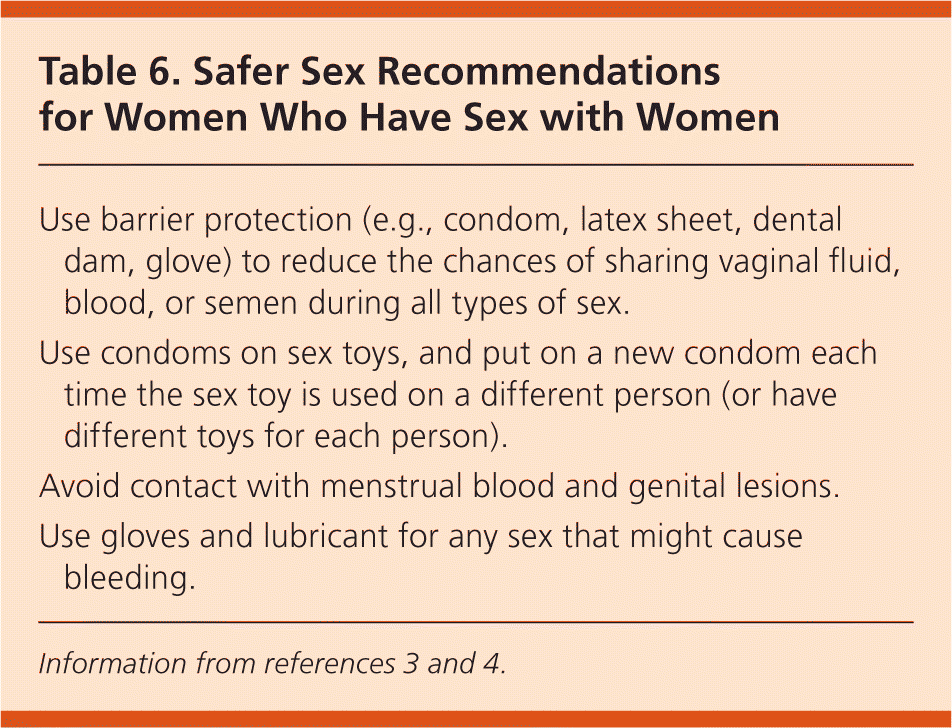
| Use barrier protection (e.g., condom, latex sheet, dental dam, glove) to reduce the chances of sharing vaginal fluid, blood, or semen during all types of sex. |
| Use condoms on sex toys, and put on a new condom each time the sex toy is used on a different person (or have different toys for each person). |
| Avoid contact with menstrual blood and genital lesions. |
| Use gloves and lubricant for any sex that might cause bleeding. |
INTIMATE PARTNER VIOLENCE
The 2010 National Intimate Partner and Sexual Violence Survey reported that the lifetime prevalence of rape, physical violence, or stalking by an intimate partner was 43.8% for lesbians, 61.1% for bisexual women, and 35.0% for heterosexual women.28 The lifetime prevalence of severe physical violence by an intimate partner was 29.4% for lesbians, 49.3% for bisexual women, and 23.6% for heterosexual women. Most bisexual women (89.5%) indicated that the perpetrators were male, but 67.4% of lesbians reported having only female perpetrators.28
Some victims may avoid seeking help because of a perceived lack of support in the health care system.42 Family physicians should use a tool such as HITS to screen for intimate partner violence in WSW.20 The AAFP recommends that physicians be familiar with resources available to assist WSW who are in danger of violence and abuse.43
Medicolegal Issues
After repeal of the Defense of Marriage Act in 2013, the Centers for Medicare and Medicaid Services declared that health insurance companies that offer spousal coverage must treat same-sex and opposite-sex spouses equally. Medicare Advantage beneficiaries with a same-sex spouse have equal access to coverage for care in a skilled nursing facility where a spouse is located, regardless of where they live.44
Federal regulations that took effect in 2011 stipulate that all hospitals participating in the Medicaid and Medicare programs must permit patients to choose their own visitors and cannot discriminate based on sexual orientation.45 To ensure that the patient's wishes about visitors and medical decision making are respected, the Human Rights Campaign suggests that all LGBT persons complete advance health care directives and visitation authorization forms, and that they discuss their wishes with their family physician in advance.46
Laws pertaining to same-sex marriage and the recognition of a partner's rights are changing rapidly and may vary according to location. Physicians should be aware of community referral resources for patients who need legal advice.
Pregnancy and Children
Although older WSW may lack a support system, including adult children, younger WSW are increasingly likely to conceive and raise children. According to the U.S. Census Bureau's 2014 American Community Survey, 21.5% of female-female couples reported having their own children (biologic, step-, or adopted) in the household.47
One option for conception is donor insemination. Physicians should provide interested WSW with referrals to health care professionals who provide this service.14 The Human Rights Campaign offers pertinent information on their website (http://www.hrc.org), including details about the advantages and risks of using a known vs. unknown sperm donor, with pointers about insurance coverage for fertility services.48
Legal recognition of nonbiologic parents can vary from state to state. Nonbiologic parents in same-sex relationships (married or not) are urged to adopt the children or to obtain a court judgment of parentage to protect their rights. Being named on a child's birth certificate does not necessarily confer the status of legal parentage.49 Physicians should be ready to make referrals to legal counsel with experience in same-sex family law.
Data Sources: A PubMed search was completed in Clinical Queries using the key terms WSW, women who have sex with women, lesbian, bisexual, LGB, and LGBT. The search included meta-analyses, randomized controlled trials, clinical trials, and reviews. Also searched were the Agency for Healthcare Research and Quality Evidence Reports, Cochrane Database of Systematic Reviews, evidence-based guidelines from the National Guideline Clearinghouse, Institute for Clinical Systems Improvement, U.S. Preventive Services Task Force, Canadian Task Force on Preventive Health Care, and Effective Health Care. Search dates: Multiple dates between November 2015, December 2015, and November 2016.
